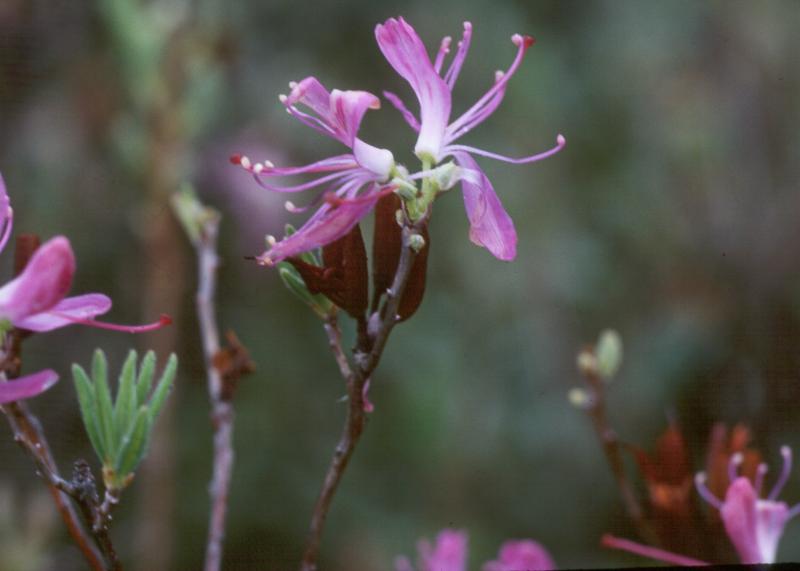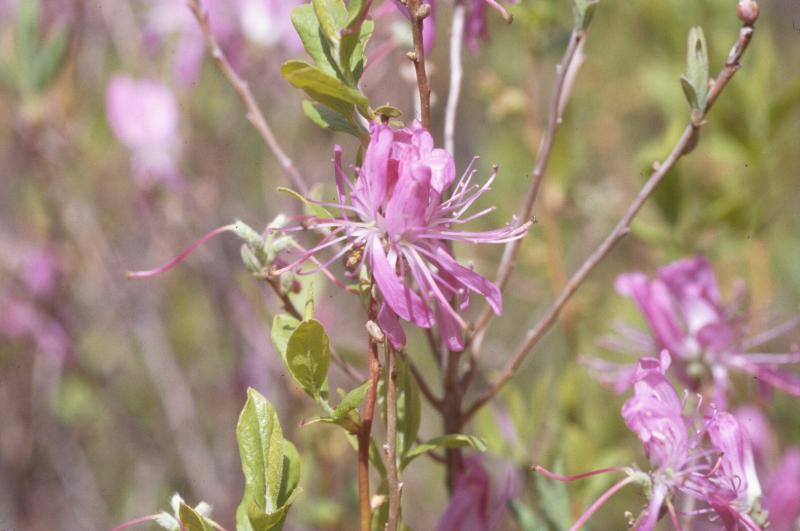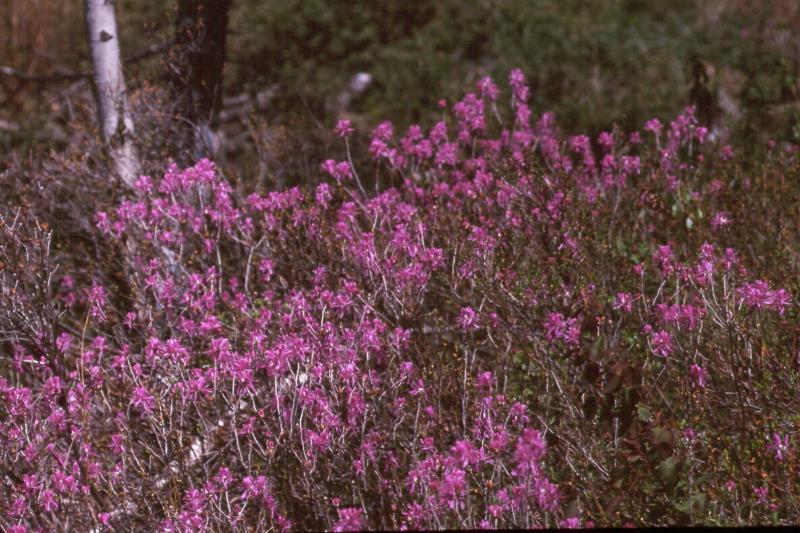Rhodora
Rhododendron canadense (L.) Torr.
- Class
- Dicotyledoneae (Dicots)
- Family
- Ericaceae (Heath Family)
- State Protection
- Threatened
Listed as Threatened by New York State: likely to become Endangered in the foreseeable future. For animals, taking, importation, transportation, or possession is prohibited, except under license or permit. For plants, removal or damage without the consent of the landowner is prohibited.
- Federal Protection
- Not Listed
- State Conservation Status Rank
- S2
Imperiled in New York - Very vulnerable to disappearing from New York due to rarity or other factors; typically 6 to 20 populations or locations in New York, very few individuals, very restricted range, few remaining acres (or miles of stream), and/or steep declines.
- Global Conservation Status Rank
- G5
Secure globally - Common in the world; widespread and abundant (but may be rare in some parts of its range).
Summary
Did you know?
This Rhododendron is fairly hard to grow since it needs just the right amount of moisture, always moist but not too wet. It is usually pollinated by female bumblebees. It looked so different from other rhododendrons that it was at one time put in the genus Rhodora, hence the common name. Rhodora is also the name of the botanical journal published by the New England Botanical Club.
State Ranking Justification
There are approximately eight known populations, and some of these have hundreds to thousands of stems. Many of these populations are within protected landscapes. Today there are few threats on these populations and the short/long term trends appear stable.
Short-term Trends
Current evidence indicates that the short-term trend has been stable and there is no reason to believe this will change anytime in the near future.
Long-term Trends
This plant was never known from more than 10 localities in New York and there are now the same number of occurrences as were known historically.
Conservation and Management
Threats
The plants are isolated enough that threats are low to insignificant.
Conservation Strategies and Management Practices
There are no management needs at this time.
Research Needs
There are no research needs at this time.
Habitat
Habitat
A shrub that may form dominant stands or only a few scattered stems in wetlands of acidic rocky summits and barrens, as well as boggy habitats containing a mixture of organic material and gravel (New York Natural Heritage Program 2004). Bogs and wet woods (Gleason and Cronquist 1991). Bogs, damp thickets, acid barrens and rocky summits and slopes (Fernald 1970).
Associated Ecological Communities
- Dwarf shrub bog
(guide)
A wetland usually fed by rainwater or mineral-poor groundwater and dominated by short, evergreen shrubs and peat mosses. The surface of the peatland is usually hummocky, with shrubs more common on the hummocks and peat moss throughout. The water in the bog is usually nutrient-poor and acidic.
- Inland poor fen*
(guide)
A wetland fed by acidic water from springs and seeps. Plant remains in these fens do not decompose rapidly and thus the plants in these fens usually grow on older, undecomposed plant parts of mostly sphagnum mosses.
- Pitch pine-heath barrens
(guide)
A shrub-savanna community that occurs on well-drained, sandy or rocky soils. The most abundant tree is pitch pine and the shrublayer is dominated by heath shrubs.
- Shrub swamp
(guide)
An inland wetland dominated by tall shrubs that occurs along the shore of a lake or river, in a wet depression or valley not associated with lakes, or as a transition zone between a marsh, fen, or bog and a swamp or upland community. Shrub swamps are very common and quite variable.
- Successional shrubland*
A shrubland that occurs on sites that have been cleared (for farming, logging, development, etc.) or otherwise disturbed. This community has at least 50% cover of shrubs.
* probable association but not confirmed.
Associated Species
- Acer pensylvanicum (striped maple)
- Acer rubrum var. rubrum (common red maple)
- Betula populifolia (gray birch)
- Chamaedaphne calyculata (leatherleaf)
- Clethra alnifolia (coastal sweet-pepperbush)
- Comptonia peregrina (sweet-fern)
- Corylus americana (American hazelnut)
- Drosera intermedia (spatulate-leaved sundew)
- Drosera rotundifolia (round-leaved sundew)
- Dulichium arundinaceum
- Gaylussacia baccata (black huckleberry)
- Kalmia angustifolia
- Kalmia latifolia (mountain laurel)
- Lindera benzoin (spicebush)
- Myrica gale (sweet gale)
- Onoclea sensibilis (sensitive fern)
- Osmunda cinnamomea
- Ostrya virginiana (hop hornbeam, ironwood)
- Pinus banksiana (jack pine)
- Pinus rigida (pitch pine)
- Pinus strobus (white pine)
- Pteridium aquilinum var. latiusculum
- Quercus rubra (northern red oak)
- Rhododendron groenlandicum (Labrador-tea)
- Rhododendron viscosum (swamp azalea)
- Rhynchospora alba (white beak sedge)
- Rubus pubescens (dwarf raspberry)
- Sassafras albidum (sassafras)
- Spiraea tomentosa (steeplebush)
- Triadenum virginicum
- Tsuga canadensis (eastern hemlock)
- Vaccinium angustifolium (common lowbush blueberry)
- Vaccinium macrocarpon (cranberry)
- Vaccinium oxycoccos (small cranberry)
Range
New York State Distribution
A showy flowering shrub located in the St. Lawrence Valley, Adirondacks, Rensselaer Plateau, and the Shawangunk Mountains. Some of our largest populations are located in the Shawangunks. New York is at the western edge of its range.
Global Distribution
The plant ranges from Newfoundland and Quebec west to Ontario, and south to eastern Pennsylvania and northern New Jersey.
Identification Comments
General Description
Rhodora is a woody shrub with ascending branches that only grows up to 1.5 meters tall. It can be seen as a single shrub or in small to very large colonies. The flowers appear when the leaves are just expanding. Each branch is topped by a cluster of four or five deep rose colored flowers with long stamens sticking out. The three main petals are divided nearly to the white-colored base and the upper petal has three lobes on the top. Since there is no flower tube the flower appears very open. The oval, deciduous leaves are 2-5 cm long, fuzzy underneath, and mainly at the ends of the branches. The dry woody fruits are whitish, fuzzy, and split open along the sides into five sections.
Identifying Characteristics
This shrub, up 1.5 meters tall, has strongly ascending branches and deciduous leaves. The inflorescences are mostly expanded before leaves. The pale pink to deep rose-purple corolla is strongly irregular with a short (to no) corolla tube. Each flower has 10 stamens with a 1.5-2 cm long style. The capsules are 0.7-1.5 cm long and glaucous-puberulent. The leaves are oblong-elliptic, blunt, and closely pubescent (rarely glaucous) beneath.
Best Life Stage for Proper Identification
While this shrub can be identified from fruit, flowers make it very easy to see and identify.
Similar Species
If observed in flower, this shrub is unique among Rhododendron species and not likely confused.
Best Time to See
This shrub flowers mid-May to mid-June. According to the records of Daniel Smiley, the Shawangunk plants typically flower around May 21st. The fruit capsules may persist on the shrub indefinitely, but the seeds generally disperse by late fall. The ideal survey time is late May, when this shrub is likely in bloom.
- Vegetative
- Flowering
- Fruiting
The time of year you would expect to find Rhodora vegetative, flowering, and fruiting in New York.
Rhodora Images
Taxonomy
Rhodora
Rhododendron canadense (L.) Torr.
- Kingdom Plantae
- Phylum Anthophyta
- Class Dicotyledoneae
(Dicots)
- Order Ericales
- Family Ericaceae (Heath Family)
- Order Ericales
- Class Dicotyledoneae
(Dicots)
- Phylum Anthophyta
Additional Common Names
- Canadian Rhododendron
- Mountain Azalea
Synonyms
- Rhodora canadense L.
Additional Resources
Best Identification Reference
Gleason, Henry A. and A. Cronquist. 1991. Manual of Vascular Plants of Northeastern United States and Adjacent Canada. The New York Botanical Garden, Bronx, New York. 910 pp.
Other References
Fernald, M.L. 1950. Gray's manual of botany. 8th edition. D. Van Nostrand, New York. 1632 pp.
Holmgren, Noel. 1998. The Illustrated Companion to Gleason and Cronquist's Manual. Illustrations of the Vascular Plants of Northeastern United States and Adjacent Canada. The New York Botanical Garden, Bronx, New York.
Mitchell, Richard S. and Gordon C. Tucker. 1997. Revised Checklist of New York State Plants. Contributions to a Flora of New York State. Checklist IV. Bulletin No. 490. New York State Museum. Albany, NY. 400 pp.
New York Natural Heritage Program. 2010. Biotics database. New York Natural Heritage Program. New York State Department of Environmental Conservation. Albany, NY.
New York Natural Heritage Program. 2024. New York Natural Heritage Program Databases. Albany, NY.
Reschke, Carol. 1990. Ecological communities of New York State. New York Natural Heritage Program, New York State Department of Environmental Conservation. Latham, NY. 96 pp. plus xi.
Weldy, T. and D. Werier. 2010. New York flora atlas. [S.M. Landry, K.N. Campbell, and L.D. Mabe (original application development), Florida Center for Community Design and Research http://www.fccdr.usf.edu/. University of South Florida http://www.usf.edu/]. New York Flora Association http://newyork.plantatlas.usf.edu/, Albany, New York
Links
About This Guide
Information for this guide was last updated on: January 15, 2009
Please cite this page as:
New York Natural Heritage Program. 2024.
Online Conservation Guide for
Rhododendron canadense.
Available from: https://guides.nynhp.org/rhodora/.
Accessed July 27, 2024.



